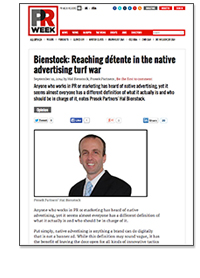 Anyone who works in PR or marketing has heard of native advertising, yet it seems almost everyone has a different definition of what it actually is and who should be in charge of it.
Anyone who works in PR or marketing has heard of native advertising, yet it seems almost everyone has a different definition of what it actually is and who should be in charge of it.
Put simply, native advertising is anything a brand can do digitally that is not a banner ad. While this definition may sound vague, it has the benefit of leaving the door open for all kinds of innovative tactics ranging from video to infographics to in-depth reporting.
Unfortunately, it also leaves open the possibility of turf wars between marketing, which might see branded content as just another form of an ad buy, and communications, which sees it as another form of storytelling and delivering a corporate narrative. More than 20 CCOs and media representatives discussed these issues during a recent Prosek Partners roundtable and explored how the best native advertising requires collaboration between the marketing and communications functions and the media partner.
First, marketing and communications must agree on the goals of a campaign. Only then can a company bring in a media partner that will help the brand reach its target audience.
Most media partners leave it to the brand to decide how involved they should be. Some brands prefer to deliver completed content directly to the media partner, which the outlet can then run as is, edit, or reject entirely. This model has worked well for Forbes and The Huffington Post, although stories published there can sometimes get lost in the massive volume of content they post each day.
Other outlets, like The New York Times and BuzzFeed, have teams of brand journalists that can help with content development, or write the content entirely. Some media outlets maintain a strict separation between these brand journalists and those who work in the traditional newsroom. At others, the line is more porous. Either way, brand journalists are trained to ask the same questions any journalist would: "Is this story interesting?" and "Is it something my readers would care about?"
For example, when Netflix wanted to promote the new season of Orange is the New Black, it worked with the Times to create a story on the lack of policies and programs that meet the needs of women in prison. The story didn’t promote the show, but it did explore many of the same issues OITNB covers.
Similarly, when a brand wanted to create conversation about the world’s energy needs as it was hosting an energy-themed conference, it worked with the Financial Times on a series of stories about the topic.
In this case, the brand had no control over the content. It simply funded the reporting. Yet in doing so, it achieved its goal of raising awareness of the topic. At the same time, the FT got the money it needed to cover an issue it thought readers would be interested in, but didn’t have the resources to report on with this level of depth.
As this new kind of storytelling evolves, it will be critical for communicators to maintain a seat at the table, most importantly at three key points.
First, the communications team should ensure all content remains aligned with the larger brand narrative, whether it actually develops that content or not.
Second, it should make the ultimate decision as to which media outlet would make the best partner. Communications has always played that role when placing editorial content; the fact that the content is part of a native advertising campaign should not change that.
Finally, once the story lands, communications should facilitate distribution through the company’s owned channels to broaden its reach and deepen the level of engagement with its target audience.
By maintaining at least this baseline level of involvement, communicators can ensure that their voices are heard and their goals are considered throughout a native advertising campaign.
Hal Bienstock is SVP at Prosek Partners.
